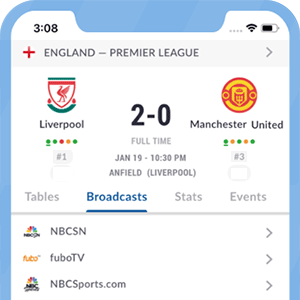
NCAA Women's Soccer
Matches
NCAA Women's Soccer Live Stream and TV Listings, Live Scores, Fixtures, Results
Broadcast Rights
Where can you watch NCAA Women's Soccer in United States?


About NCAA Women's Soccer
NCAA Women's Soccer History, Format, Organization, Media Coverage
The NCAA Division I men's soccer tournament (also known as the College Cup during the semi-finals and the championship rounds) is an annual American intercollegiate soccer competition to determine the Division I men’s national champion. It was created in 1959 and is organized by the National Collegiate Athletic Association (NCAA). The first edition of this competition featured eight teams, but the tournament proper has since expanded over the years to include a total of 48 teams as of the 2023/24 NCAA Division I season.
St. Louis University, Indiana University, the University of Virginia, and the University of Maryland are among the teams to have won multiple NCAA Division I titles. In more recent years, other schools, such as Stanford University, Georgetown University, and Syracuse University, have also won at least one NCAA Division I title.
During the regular season, over 200 teams spread across 20-plus conferences compete to win their respective conferences and put themselves in good stead to qualify for the NCAA Division I men’s soccer tournament, which features 48 teams. In its current format, the NCAA Division I men’s tournament is a single-elimination competition. Some of the teams qualify through receiving automatic bids (which usually is through winning a team’s conference), while others receive “at-large” bids (which is determined by a committee who calculates a team’s overall strength and performance using a variety of metrics).
The 48 teams are then seeded (ranked) by the NCAA selection committee, and the top 16 teams receive a “bye”, which is a pass to skip the first round. The other remaining 32 teams are then grouped by geography, and will play each other for a chance to compete against the top 16 teams in the second round.
During the first four rounds, the top seeded (ranked) team gets an additional benefit - to host the match. However, once the competition progresses to the semi-final and finals, commonly known as the College Cup, matches are played at a predetermined neutral side so as not to give any team any form of home pitch advantage.
The final four teams to compete in the College Cup are the winners of four brackets called “Regional One”, “Regional Two”, “Regional Three”, and “Regional Four”.
In addition to Division I, NCAA Men’s Soccer also has two other divisions: Division II and Division III. The NCAA Division II Men’s Soccer tournament was created in the early 1970s to help separate tiers for collegiate men’s soccer teams. To date, Southern Connecticut State University and Seattle Pacific University are among the most successful teams in Division II (D-II) men’s soccer history.
Meanwhile, Division III was also created in the early 1970s and holds its own separate soccer tournament each season. The most successful team in Division III (D-III) history is Messiah University, while Tufts University has recently emerged as a major powerhouse in D-III men’s soccer since the start of the 21st century.
Media coverage
In the USA, the NCAA Division I men’s soccer competition was primarily covered by ESPN during the late 1970s through the early 1990s. From the mid 1990s through much of the first two decades of the 21st century, broadcasts shifted to the College Sports Television (CSTV) network, before ESPN acquired TV broadcast rights to show games through its college-focused channel, ESPNU. The network then renewed its deal in a multi-year arrangement in the early 2020s to broadcast and live-stream NCAA Division I men’s soccer games.
In addition, several regional conferences, such as the Pac-12, ACC, and others, also regularly show and live-stream their conference’s games through their own partnerships with ESPN. Meanwhile, FuboTV is another resource to live-stream NCAA Division I men’s soccer games for viewers based in the United States.
















